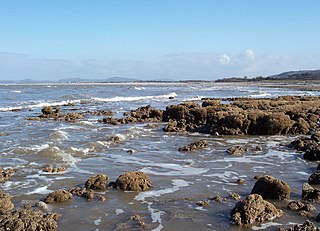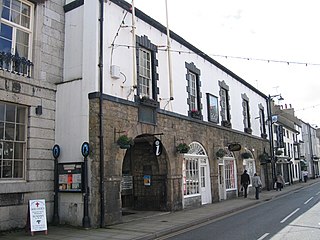
Llandudno is a seaside resort, town and community in Conwy County Borough, Wales, located on the Creuddyn peninsula, which protrudes into the Irish Sea. In the 2011 UK census, the community – which includes Gogarth, Penrhyn Bay, Craigside, Glanwydden, Penrhynside, and Bryn Pydew – had a population of 20,701. The town's name means "Church of Saint Tudno".

Historic Denbighshire is one of thirteen traditional counties in Wales, a vice-county and a former administrative county, which covers an area in north east Wales. It is a maritime county, bounded to the north by the Irish Sea, to the east by Flintshire, Cheshire and Shropshire, to the south by Montgomeryshire and Merionethshire, and to the west by Caernarfonshire.

Colwyn Bay is a town, community and seaside resort in Conwy County Borough on the north coast of Wales overlooking the Irish Sea. It lies within the historic county of Denbighshire. Eight neighbouring communities are incorporated within its postal district. Established as its own separate parish in 1844 with just a small grouping of homes and farms where the community of Old Colwyn stands today, Colwyn Bay has expanded to become the second-largest community and business centre in the north of Wales as well as the 14th largest in the whole of Wales with the urban statistical area, including Old Colwyn, Rhos-on-Sea, and Mochdre and Penrhyn Bay, having a population of 34,284 at the 2011 census.

Rhos-on-Sea is a seaside resort and community in Conwy County Borough, Wales. The population was 7,593 at the 2011 census. It adjoins Colwyn Bay and is named after the Welsh kingdom of Rhos established there in late Roman Britain as a sub-kingdom of Gwynedd. It later became a cantref (hundred).

Old Colwyn is a large village just to the east of Colwyn Bay, in Conwy County Borough, Wales.

Abergele & Pensarn railway station is a railway station on the North Wales Coast Line which serves both the town of Abergele and suburb of Pensarn in Conwy County Borough, Wales.
The Vale of Clwyd and Conwy Football League was a football league formed in 2011 following the split of the Clwyd Football League, which itself was formed in 1974 as an amalgamation of the Dyserth and the Halkyn Mountain League. The Premier Division was in the fifth level of the Welsh football league system in North Wales. The league folded in 2020 due to a reorganisation of the Welsh football league pyramid, with many teams joining the North Wales Coast East Football League.
The LL postcode area, also known as the Llandudno postcode area, is a group of 67 postcode districts, within 62 post towns. These cover the majority of north Wales, plus a very small part of west Wales and the English county of Shropshire. The districts start at LL11 so as to avoid confusion with Liverpool postcodes.
Ysgol y Creuddyn is a Welsh-medium secondary school, situated in Penrhyn Bay outside Llandudno, Wales, named after the Creuddyn peninsula. The school was founded on Wednesday, the 2nd of September 1981 with 218 students, and is now home to over 600 students. Students are bilingual, with all subjects taught in the Welsh language up to GCSE level.

St David's Welsh Church, Colwyn Bay is in Rhiw Road, Colwyn Bay, Conwy County Borough, Wales. It is an Anglican church in the parish of Colwyn Bay with Bryn-Y-Maen, the deanery of Rhos, the archdeaconry of St Asaph, and the diocese of St Asaph. The church is situated behind St Paul's Church and is a Grade II listed building.
Llety'r Dryw is a house in Abergele Road, Colwyn Bay, Conwy, Wales. It is a Grade II listed building. It was built in 1893 for John Eden and designed by the Chester firm of architects, Douglas and Fordham. About 1960 it came into the possession of Denbighshire County Council and was used as the Fire Brigade Headquarters; then, in about 1990 it was taken over by the North Wales Police Authority. The house has been described as a "simple stone-built villa", which has been "inspired by 17th-century vernacular work of Northern England". The listing description says it is a "freely interpreted neo-vernacular house of considerable architectural quality".

Llanddulas and Rhyd-y-foel is a community in Conwy County Borough, in Wales. It is located on the coast of Liverpool Bay, at the mouth of the Afon Dulas, 2.7 miles (4.3 km) west of Abergele, 3.6 miles (5.8 km) east of Colwyn Bay and 9.0 miles (14.5 km) east of Conwy. As the name suggests, it consists of the villages of Llanddulas and Rhyd-y-foel. At the 2001 census the community had a population of 1,572, reducing slightly to 1,542 at the 2011 census.
Grŵp Llandrillo Menai (GLlM) is an umbrella organisation overseeing the operation of three member colleges in North Wales: Coleg Llandrillo, Coleg Menai and Coleg Meirion-Dwyfor.
The North Wales Coast East Football League is a football league in Wales, at tiers 4 and 5 of the Welsh football league system in north Wales, founded in 2020. The league is under the control of the North Wales Coast Football Association. The league replaced the former Vale of Clwyd and Conwy Football League, and covers the north east of Wales. A corresponding North Wales Coast West Football League was also established at the same time.
The North Wales Coast FA Junior Challenge Cup is a football knockout tournament involving teams from in North Wales who play in leagues administered and associated with the North Wales Coast Football Association.

Beaumaris Town Hall is a municipal building on Castle Street, in Beaumaris, Anglesey, Wales. The structure, which is the meeting place of Beaumaris Town Council, is a Grade II listed building.

Conwy County Borough is a county borough in the north of Wales. It covers an area of 1,126 km2 (435 sq mi) and had a population of approximately 114,800 in 2021.










